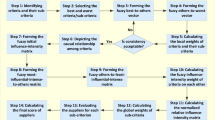Abstract
A centrally managed system (CMS) is typically a system operating under a central management who controls the activity of all decision making units (DMUs) to enhance the overall performance of the system. An important distinguishing feature of CMS, pertinent to the efficiency evaluation, is that only one strong supporting hyperplane of the production possibility set (PPS), the one that the aggregated unit is projected on, matters. As a result the ordinary definition of cross-efficiency which is based on projection on different supporting hyperplane of PPS, renders itself inapplicable. We introduce the concept of peer-evaluation in CMS and define the individual cross-efficiency score of the DMU under evaluation by aggregating the individual self-evaluated efficiency and the peer-evaluated individual efficiencies obtained using the most favorable CRA plans of other DMUs. These cross-efficiency scores may not be unique due to the presence of several most favorable CRA plans for the DMU under evaluation. To address this issue, we propose several secondary goal models in both aggressive and benevolent perspectives. The effectiveness of the proposed models is examined using a real dataset.

Similar content being viewed by others
References
Afsharian, M., Ahn, H., & Thanassoulis, E. (2017). A DEA-based incentives system for centrally managed multi-unit organisations. European Journal of Operational Research, 259(2), 587–598.
Afsharian, M., Ahn, H., & Thanassoulis, E. (2019). A frontier-based system of incentives for units in organisations with varying degrees of decentralisation. European Journal of Operational Research, 275(1), 224–237.
An, Q., Tao, X., Xiong, B., & Chen, X. (2022). Frontier-based incentive mechanisms for allocating common revenues or fixed costs. European Journal of Operational Research, 302(1), 294–308.
Asmild, M., Paradi, J. C., & Pastor, J. T. (2009). Centralized resource allocation BCC models. Omega, 37(1), 40–49.
Banker, R. D., Charnes, A., & Cooper, W. W. (1984). Some models for estimating technical and scale inefficiencies in data envelopment analysis. Management Science, 30, 1078–1092.
Boussofiane, A., Dyson, R. G., & Thanassoulis, E. (1991). Applied data envelopment analysis. European Journal of Operational Research, 52(1), 1–15.
Charnes, A., & Cooper, W. W. (1961). Management models and industrial applications of linear programming. Technical report.
Charnes, A., Cooper, W. W., & Ferguson, R. (1955). Optimal estimation of executive compensation by linear programming. Management Science, 1(6), 138–151.
Charnes, A., Cooper, W. W., & Rhodes, E. (1978). Measuring the efficiency of decision making units. European Journal of Operational Research, 2(6), 429–444.
Chen, M., Ang, S., Jiang, L., & Yang, F. (2020). Centralized resource allocation based on cross-evaluation considering organizational objective and individual preferences. OR Spectrum, 42, 529–565.
Dai, Q., Li, Y., Lei, X., & Wu, D. (2021). A DEA-based incentive approach for allocating common revenues or fixed costs. European Journal of Operational Research, 292(2), 675–686.
Davtalab Olyaie, M., Roshdi, I., Jahanshahloo, G., & Asgharian, M. (2014). Characterizing and finding full dimensional efficient facets in DEA: A variable returns to scale specification. Journal of the Operational Research Society, 65(9), 1453–1464.
Davtalab-Olyaie, M., & Asgharian, M. (2020). On Pareto-optimality in the cross-efficiency evaluation. European Journal of Operational Research, 12.
Davtalab-Olyaie, M., Mahmudi-Baram, H., & Asgharian, M. (2021). Incentivizing units in centralized systems: A slacks-based approach. Journal of the Operational Research Society, 1–18.
Davtalab-Olyaie, M., Mahmudi-Baram, H., & Asgharian, M. (2022). Measuring individual efficiency and unit influence in centrally managed systems. Annals of Operations Research,, 1–26.
Davtalab-Olyaie, M. (2019). A secondary goal in DEA cross-efficiency evaluation: A one home run is much better than two doubles criterion. Journal of the Operational Research Society, 70(5), 807–816.
Davtalab-Olyaie, M., Ghandi, F., & Asgharian, M. (2021). On the spectrum of achievable targets in cross-efficiency evaluation and the associated secondary goal models. Expert Systems with Applications, 177, 114927.
Dehnokhalaji, A., Ghiyasi, M., & Korhonen, P. (2017). Resource allocation based on cost efficiency. Journal of the Operational Research Society, 68(10), 1279–1289.
Ding, T., Chen, Y., Wu, H., & Wei, Y. (2018). Centralized fixed cost and resource allocation considering technology heterogeneity: A DEA approach. Annals of Operations Research, 268, 497–511.
Doyle, J. R., & Green, R. H. (1994). Efficiency and cross-efficiency in DEA: Derivations, meanings and uses. Journal of the Operational Research Society, 45, 567–578.
Du, J., Cook, W. D., Liang, L., & Zhu, J. (2014). Fixed cost and resource allocation based on DEA cross-efficiency. European Journal of Operational Research, 235(1), 206–214.
Du, J., Liang, L., Chen, Y., & Bi, G. B. (2010). DEA-based production planning. Omega, 38(1–2), 105–112.
Ehrgott, M. (2005). Multicriteria optimization. Springer.
Fang, L. (2016). Centralized resource allocation DEA models based on revenue efficiency under limited information. Journal of the Operational Research Society, 67(7), 945–952.
Fang, L. (2020). An incentive approach based on data envelopment analysis for intra-organization yardstick competition. Journal of the Operational Research Society, 71(1), 153–160.
Fang, L. (2022). Measuring and decomposing group performance under centralized management. European Journal of Operational Research, 297(3), 1006–1013.
Fang, L., & Li, H. (2015). Centralized resource allocation based on the cost-revenue analysis. Computers & Industrial Engineering, 85, 395–401.
Fang, L., Li, H., & Wang, Z. (2021). Centralized resource allocation based on the bargaining approach. Asia-Pacific Journal of Operational Research, 38(02), 2050049.
Jahanshahloo, G. R., Hosseinzadeh Lofti, F., Yafari, Y., & Maddahi, R. (2011). Selecting symmetric weights as a secondary goal in DEA cross-efficiency evaluation. Applied Mathematical Modelling, 35, 544–549.
Jahanshahloo, G. R., Roshdi, I., & Davtalab-Olyaie, M. (2013). Characterizing and finding full dimensional efficient facets of PPS with constant returns to scale technology. International Journal of Industrial Mathematics, 5, 149–159.
Korhonen, P., & Syrjänen, M. (2004). Resource allocation based on efficiency analysis. Management Science, 50(8), 1134–1144.
Liang, L., Wu, J., Cook, W. D., & Zhu, J. (2008). The DEA game cross-efficiency model and its Nash equilibrium. Operations Research, 56(5), 1278–1288.
Liang, L., Wu, J., Cook, W. D., & Zhu, J. (2008). Alternative secondary goals in DEA cross efficiency evaluation. International Journal of Production Economics, 113, 1025–1030.
Lotfi, F. H., Noora, A. A., Jahanshahloo, G. R., Gerami, J., & Mozaffari, M. (2010). Centralized resource allocation for enhanced russell models. Journal of Computational and Applied Mathematics, 235(1), 1–10.
Lozano, S., & Villa, G. (2004). Centralized resource allocation using data envelopment analysis. Journal of Productivity Analysis, 22(1), 143–161.
Lozano, S., & Villa, G. (2005). Centralized DEA models with the possibility of downsizing. Journal of the Operational Research Society, 56(4), 357–364.
Maddahi, R., Jahanshahloo, G. R., Hosseinzadeh Lofti, F., & Ebrahimnejad, A. (2014). Optimising proportional weights as a secondary goal in DEA cross-efficiency evaluation. International Journal of Operational Research, 19, 234–245.
Mar-Molinero, C., Prior, D., Segovia, M.-M., & Portillo, F. (2014). On centralized resource utilization and its reallocation by using DEA. Annals of Operations Research, 221(1), 273–283.
Ma, R., Yao, L., Jin, M., & Ren, P. (2014). The DEA game cross-efficiency model for supplier selection problem under competition. Applied Mathematics & Information Sciences, 8(2), 811.
Nasrabadi, N., Dehnokhalaji, A., Kiani, N. A., Korhonen, P. J., & Wallenius, J. (2012). Resource allocation for performance improvement. Annals of Operations Research, 196, 459–468.
Olesen, O. B., & Petersen, N. C. (2003). Identification and use of efficient faces and facets in DEA. Journal of Productivity Analysis, 20, 323–360.
Pastor, J. T., Ruiz, J. L., & Sirvent, I. (1999). An enhanced DEA Russell graph efficiency measure. European Journal of Operational Research, 115(3), 596–607.
Sadeghi, J., & Dehnokhalaji, A. (2019). A comprehensive method for the centralized resource allocation in DEA. Computers & Industrial Engineering, 127, 344–352.
Sexton, T. R., Silkman, R. H., & Hogan, A. J. (1986). Data envelopment analysis: Critique and extensions. New Directions for Program Evaluation, 32, 73–105.
Soltanifar, M., Hosseinzadeh Lotfi, F., Sharafi, H., & Lozano, S. (2022). Resource allocation and target setting: A CSW-DEA based approach. Annals of Operations Research, 318(1), 557–589.
Varmaz, A., Varwig, A., & Poddig, T. (2013). Centralized resource planning and yardstick competition. Omega, 41(1), 112–118.
Wang, Y. M., & Chin, K. S. (2010). Some alternative models for DEA cross-efficiency evaluation. International Journal of Production Economics, 128, 332–338.
Wu, J., Chu, J., Sun, J., & Zhu, Q. (2016). DEA cross-efficiency evaluation based on Pareto improvement. European Journal of Operational Research, 248(2), 571–579.
Wu, J., Liang, L., & Yang, F. (2009). Determination of the weights for the ultimate cross efficiency using Shapley value in cooperative game. Expert Systems with Applications, 36(1), 872–876.
Wu, J., Sun, J., Liang, L., & Zha, Y. (2011). Determination of weights for ultimate cross efficiency using Shannon entropy. Expert Systems with Applications, 38(5), 5162–5165.
Wu, J., Sun, J., Zha, Y., & Liang, L. (2011). Ranking approach of cross-efficiency based on improved TOPSIS technique. Journal of Systems Engineering and Electronics, 22(4), 604–608.
Zhou, Z., Lin, L., Xiao, H., Ma, C., & Wu, S. (2017). Stochastic network DEA models for two-stage systems under the centralized control organization mechanism. Computers & Industrial Engineering, 110, 404–412.
Zhu, W., Huang, Y., & Yu, Y. (2023). DEA model for partial centralization resource allocation among independent subset of DMUs. Computers & Industrial Engineering, 176, 109013.
Acknowledgements
The authors would like to express their sincere thanks to the Editor and the referee for their constructive comments.The research of the third author is supported by the Natural Science and Engineering Research Council (NSERC) of Canada [NSERC RGPIN-2018-05618].
Author information
Authors and Affiliations
Corresponding author
Ethics declarations
Conflict of interest
The authors have no competing interests to declare that are relevant to the content of this article.
Ethical approval
This article does not contain any studies with human participants or animals performed by any of the authors.
Additional information
Publisher's Note
Springer Nature remains neutral with regard to jurisdictional claims in published maps and institutional affiliations.
Rights and permissions
Springer Nature or its licensor (e.g. a society or other partner) holds exclusive rights to this article under a publishing agreement with the author(s) or other rightsholder(s); author self-archiving of the accepted manuscript version of this article is solely governed by the terms of such publishing agreement and applicable law.
About this article
Cite this article
Ghandi, F., Davtalab-Olyaie, M. & Asgharian, M. Peer-evaluation in centrally managed systems. Ann Oper Res 333, 439–459 (2024). https://doi.org/10.1007/s10479-023-05740-5
Received:
Accepted:
Published:
Issue Date:
DOI: https://doi.org/10.1007/s10479-023-05740-5




